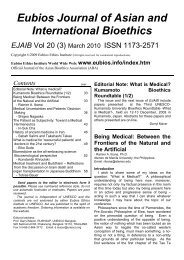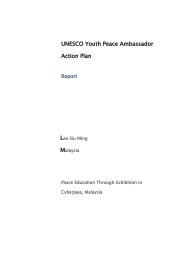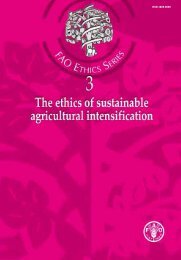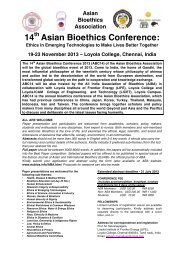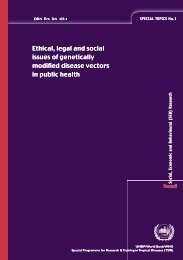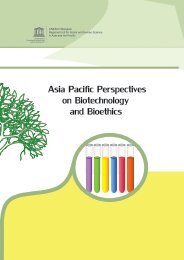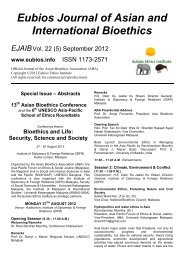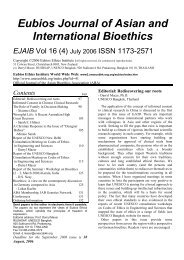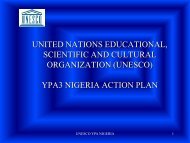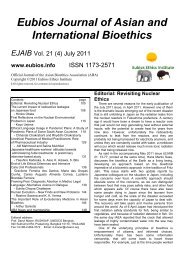Eubios Journal of Asian and International Bioethics EJAIB
Eubios Journal of Asian and International Bioethics EJAIB
Eubios Journal of Asian and International Bioethics EJAIB
- No tags were found...
You also want an ePaper? Increase the reach of your titles
YUMPU automatically turns print PDFs into web optimized ePapers that Google loves.
<strong>Eubios</strong> <strong>Journal</strong> <strong>of</strong> <strong>Asian</strong> <strong>and</strong> <strong>International</strong> <strong>Bioethics</strong> 18 (January 2008) 17ecological, ethological nature. Our current ethical valuationsdem<strong>and</strong> novelty in terms <strong>of</strong> creative thinking. Our humanity isgrounded in the organic <strong>and</strong> animated by the “greatevolutionary drama <strong>of</strong> ecological life” (Donnelley 2002:172).Like the Hindu myth <strong>of</strong> Indra’s web, human biology <strong>and</strong>consciousness are inter-dependent with other physical <strong>and</strong>biological systems. The stark predictions <strong>of</strong> global warming<strong>and</strong> its threat to biodiversity will require a supreme moral shiftin human consciousness.ReferencesAppadurai. Arjun. 1996. Modernity at Large: Cultural Dimensions <strong>of</strong>Globalization. Minneapolis: University <strong>of</strong> Minnesota Press.Bateson, Gregory. 2000. (1971) Steps to an Ecology <strong>of</strong> Mind.Chicago/London: University <strong>of</strong> Chicago Press.Bateson, Gregory. 2002. Mind <strong>and</strong> Nature: A Necessary Unity.Cresskill, New Jersey: Hampton Press.Benyus, Janine. 1997. Biomimicry. New York: Morrow.Boulding, Kenneth. E. 1995. “The Range <strong>of</strong> Possible Futures.” InElise Boulding, Kenneth E. Boulding (Eds.), The Future: Images<strong>and</strong> Processes. Thous<strong>and</strong> Oaks, CA. Sage. Pp. 39-56.Capra, Fritj<strong>of</strong>. 1996. The Web <strong>of</strong> Life: A New Synthesis <strong>of</strong> Mind <strong>and</strong>Matter. London: Harper Collins.Capra, Fritj<strong>of</strong>. 2002. The Hidden Connections: A Science forSustainable Living. New York: Anchor Books.Donnelley, Strachan. 2002. “Leopold’s Darwin: Climbing Mountains,Developing L<strong>and</strong>.” In Stephen R. Kellert & Timothy J. Farnham(Eds.), The Good in Nature <strong>and</strong> Humanity: Connecting Science,Religion, <strong>and</strong> Spirituality with the Natural World. Washington: Isl<strong>and</strong>Press. Pp. 161-174.Dysart, Gale, Deborah. 2006. Cutural Sensitivity Beyond Ethnicity: AUniversal Precautions Model. The Internet <strong>Journal</strong> <strong>of</strong> Allied HealthSciences <strong>and</strong> Practice January; 4 (1).Ehrlich, Paul. R. 2000. Human Natures: Genes, Cultures, <strong>and</strong> theHuman Project. Washington D.C. & Covelo, California: Isl<strong>and</strong>Press.Held, David. 2005. “At the Global Crossroads: The End <strong>of</strong> theWashington Consensus <strong>and</strong> the Rise <strong>of</strong> Global Social Democracy?”Globalizations May; 2 (1):95–113.H<strong>of</strong>stede, Gert. 2001. Culture’s Consequences: Comparing Values,Behaviors Institutions <strong>and</strong> Organizations Across Nations. 2 ndEdition. Thous<strong>and</strong> Oaks, CA: Sage.Laszlo, Ervin. 1994. Vision 2020: Reordering Chaos for GlobalSurvival. U.S.A.: Gordon & Breach Science Publishers.Laszlo, Ervin. Artigiani, Robert. Combs, Allan. Csányi. Vilemos. 1996.Changing Visions: Human Cognitive Maps: Past, Present, <strong>and</strong>Future. London: Adamantine Press Limited.Leavitt, Frank. 2004. “Human Biodiversity: What Can We Learn fromThe History <strong>of</strong> Human Mapping.” In Darryl R. J. Macer (ed.),Challenges for <strong>Bioethics</strong> from Asia. Tsukuba Science City, Japan.<strong>Eubios</strong> Ethics Institute. Pp. 68-71.Leopold, A. 1966. A S<strong>and</strong> County Almanac, with Other Essays onConversation from Round River. New York: Oxford UniversityPress.Maturana, Humberto., Varela, Francisco. 1987. The Tree <strong>of</strong>Knowledge. Boston: Shambhala.Montuori, Alfonso. 1993. Knowledge, Learning, <strong>and</strong> Change:Exploring the Systems/Cybernatic Perspective. In Mastery <strong>of</strong> Mind,eds. L. Bradburn & J. Petranker, pp. 252-297. Berkeley,CA:Dharma Press. (Accessed on August 1 2006, athttp://www.ciis.edu/faculty/articles/montuori/knowledgelearningchange.pdf)Pittock B., Wratt, D. 2001. “Australia <strong>and</strong> New Zeal<strong>and</strong>”. In M.Manning, C. Nobre (Eds.), Report <strong>of</strong> Working Group II <strong>of</strong> theIntergovernmental Panel on Climate Change. Geneva: 2001. pp.593-639.Preble, David., Safina Carl. 2002. “A Rising Tide for Ethics.” InStephen R. Kellert & Timothy J. Farnham (Eds.), The Good inNature <strong>and</strong> Humanity: Connecting Science, Religion, <strong>and</strong>Spirituality with the Natural World. Washington: Isl<strong>and</strong> Press. Pp.175-181.Sharma, R. N. 2003. “Ethosphere <strong>and</strong> Cosmosphere: Two NewConcepts for World <strong>Bioethics</strong> <strong>and</strong> Their Application to the <strong>Asian</strong>Segment.” In Song Sang-Yong, Koo Young-Mo, Darryl R. J. Macer.(Eds.), <strong>Asian</strong> <strong>Bioethics</strong> in the 21 st Century. Pp. 331-334.Teilhard de Chardin, Pierre. 1961. The Phenomenon <strong>of</strong> Man. NewYork: Harper & Row.Thompson, William, Irvin. 1996. Coming into Being: Artefacts <strong>and</strong>Texts in the Evolution <strong>of</strong> Consciousness. New York: St Martin’sGriffin.The Tyranny <strong>of</strong> Rightsversion 3.9.07- Brewster Kneen2746 Cassels St., Ottawa ON K2B 6N7, CanadaE-mail: brewster@ramshorn.ca www.ramshorn.caWhile I take responsibility for this text, I am certainly notits sole author. It has benefited from the critiques, comments<strong>and</strong> wisdom <strong>of</strong> a large number <strong>of</strong> people. Like open sources<strong>of</strong>tware, this is not a finished text. It is simply the version <strong>of</strong> 3September, 2007, as indicated above. You are invited tocontribute to subsequent versions.Before reading this paper, please consider how manytimes you have read or heard the word ‘rights’ when itselimination, or replacement by more explicit terms, wouldhave strengthened the message.IntroductionThe argument <strong>of</strong> this paper is that the concept <strong>of</strong> ‘rights’ isembedded in <strong>and</strong> arises from the particular culture <strong>of</strong>individualism, materialism <strong>and</strong> rationalism that arose out <strong>of</strong>the European Enlightenment. In recent years, the language <strong>of</strong>rights has gained increasing usage, if not currency, bothwithin Western society <strong>and</strong> more broadly, as code thatidentifies an idea, principle, or even legal condition as a proxyfor actualization <strong>of</strong> what is designated as a right. Thus the‘right to food’ is stated as a moral claim but it does nothing initself to ensure that the person or persons actually get food.Given that ‘rights,’ like property, are socially constructed, itis essential to recognize that any discussion <strong>of</strong> rights <strong>and</strong>property must acknowledge its specific context. In this paper Iam not pretending to present a universal critique but only adiscussion <strong>of</strong> what I consider the relevant history <strong>and</strong> socialcontext <strong>of</strong> the current all-too-common advocacy <strong>of</strong> (human)rights as the solution to social <strong>and</strong> individual injustice. To besure, there are histories <strong>of</strong> struggle not simply for individualrights <strong>and</strong> justice, but for social <strong>and</strong> collective ‘rights’ <strong>and</strong>justice such as the 1960s civil rights movement in the USAwhich was always called ‘the civil rights movement,’ not ‘thehuman rights movement.’ It was launched when a tired RosaParks decided to sit down in the front <strong>of</strong> the bus inBirmingham, Alabama, not when some lawyer pleaded a casefor the right <strong>of</strong> blacks to sit at the front <strong>of</strong> the bus before awhite court.While the civil rights movement did achieve a vastincrease in social justice in the USA, it has to be noted thatsome <strong>of</strong> the individuals <strong>and</strong> organizations that were majorplayers in that struggle have since become distressingly rightwingpolitically. For example, CORE, the Congress on RacialEquality, which was one <strong>of</strong> the leading civil rightsorganizations, suffered a right-wing takeover by a black man<strong>and</strong> re-manufactured Martin Luther King into a drug salesman<strong>and</strong> purveyor <strong>of</strong> genetically engineered food! One has towonder if a lack <strong>of</strong> discernment between individual <strong>and</strong> socialrights allowed for this unfortunate shift. A contrastingsituation might be found in Latin America where ‘social rights’have a long history, particularly in the Christian churches, <strong>and</strong>are assumed as an aspect <strong>of</strong> the fabric <strong>of</strong> social life. While acomparative study <strong>of</strong> rights <strong>and</strong> cultures would be a worthyproject, this is not my objective here.The language <strong>of</strong> rights has, in recent years, come toassume a place <strong>of</strong> honour <strong>and</strong> utility in the discourse <strong>of</strong> NGOs<strong>and</strong> CSOs, as well as liberal <strong>and</strong> conservative politics.Whether it be in reference to human rights or property rights,



